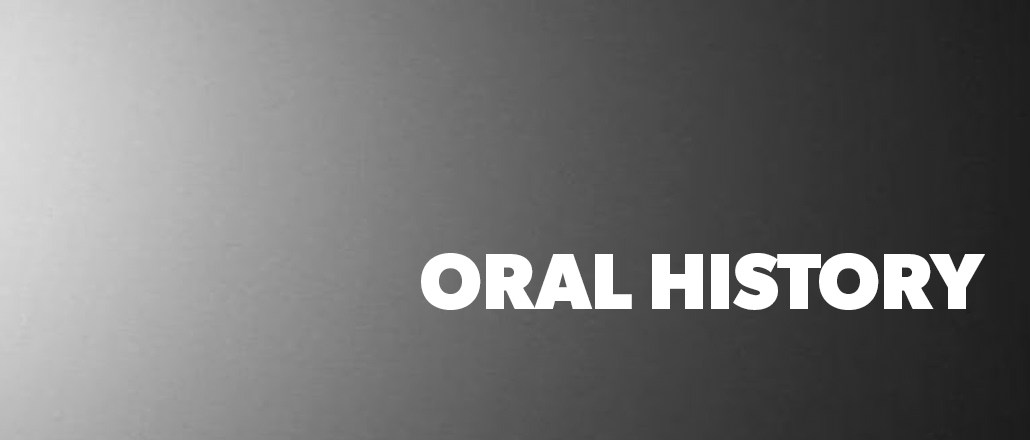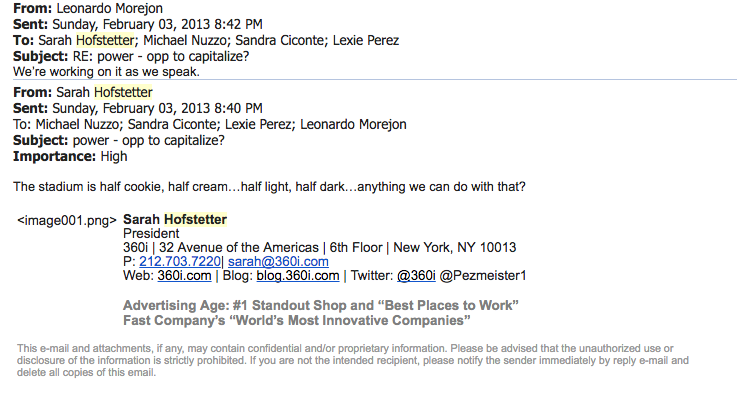The definitive oral history of the Oreo ‘You can still dunk in the dark’ Super Bowl tweet

On February 3, 2013, the San Francisco 49ers played the Baltimore Ravens to decide the NFL champion for the year. During the game, a blackout turned off power in the Mercedes-Benz Superdome, where the game was being played. At 8:48 p.m., Oreo tweeted this:
Power out? No problem. pic.twitter.com/dnQ7pOgC
— Oreo Cookie (@Oreo) February 4, 2013
It was the tweet heard around the world, with over 15,000 retweets, breathless proclamations about the future of marketing and, of course, awards for 360i, the creative agencies, Kraft and MediaVest, the media agency. All in all, about 15 people worked on the tweet.
Here is the story of the tweet, from some of those who lived through that moment.
Michael Nuzzo, creative director, 360i: The whole way of working like this had not been anything new. The war room thing was not new. We’d been working like this since 2012.
Lisa Mann, then-vp of cookies at Kraft: I always say, that it took two years to do that tweet. Everyone thinks it just happened. We’d made this decision, with Oreo’s 100th birthday coming up, that we were America’s No. 1 cookie, and a part of everyone’s personal cultural journeys.
Sarah Hofstetter, CEO, 360i: So Oreo got the muscle memory because of Daily Twist, the campaign to celebrate the 100th birthday of the Oreo. We started experimenting with commenting on culture. None of this would have happened if they hadn’t gotten comfortable with that concept.
Nuzzo: We had these daily content calendars across social platforms and every day we would review the content calendar. We’d been very thoughtful, planned in advance what we would do. Short of a meteor falling out of the sky, we knew.
Mann: We had picked events. We knew we were going to have our first Super Bowl spot. We were kicking off this whole “Are you a cookie person or are you a creme person?” idea. So, I’d been invited to go to the game in New Orleans, and to lots of parties. I turned everything down. I wanted to be on my couch in my house with my family and I wanted to watch the game as a consumer.
Hofstetter: So when we found out they were buying a Super Bowl ad, we said, we’re not going to abandon this brand muscle memory we had. That’s what got the newsroom in the first place. We knew we needed to be at the ready.
Maggie Walsh, strategist, 360i: We had all this success coming off Daily Twist. We’d been redefining what real-time meant.
Nuzzo: The day before the Super Bowl, we did a dry run. I don’t think the client was there. This was four years ago, and I’m 43, my memory is going. I was making sure the technology was working, the TVs were working. We tested.
Walsh: We had this dry run on the Saturday. And we had this worksheet: So what happens if this person does this, this person does this, who writes the copy, who presses send. We had all the tracking in place.
Sunday, February 13, 2013
Walsh: I think I came into the office early, maybe late morning. We had this projector up on the screen. We had to make sure we had the right snacks.
Nuzzo: I came in around midday. We were just hanging out.
Hofstetter: I was at home. We made brisket sliders. I was watching with my kids and my laptop and phone.
Mann: I was excited and nervous. But it was more that crazy fine line between anxiety and excitement. Because on one hand I was so excited! And we had this war room.
Walsh: We were excited. We overprepared for everything. We just set up for the first few hours.
Nuzzo: Our creative was set. We were doing this who was going to win thing, so based on that the creme in the cookie would be purple, or gold. We kept making sure the TVs worked and the audio worked.
Mann: It was the first time we were sending people to Instagram via the spot and nobody had used Instagram yet, really. We were engaging people on the war between cookie lovers and creme lovers. And I was told: the number of people who went to Instagram would be the number that mattered.
Walsh: Once pre-game started, things started ticking. We had a lot of prep involved. Wanted to have a few posts ready for the National Anthem and Beyoncé’s halftime, that stuff.
Nuzzo: We were just going as things go, doing our posts.
Mann: I was mildly interested in the football. My husband made my favorite hors d’oeuvres, we had two of three kids home. I was eating Asian-spiced chicken legs. I was focused on the commercial coming.
Hofstetter: I emailed everyone a lot. Asking how everyone was holding up.
Walsh: It kind of flew by.
The lights go out
Walsh: I was actually eating Oreos and the lights went out. And my dog was running around the office.
David Griner, digital managing editor, Adweek: All of us who were covering the game in real time (I was live tweeting for Adweek) were thrown for a loop with the blackout. It wasn’t even clear what was happening or how serious it was. The audio cut out and the stadium grew dim—though not “dark”—so it was hard to tell if it was a technical problem or something more serious. It’s very hard to be creative and funny in a chaotic moment like that.
Nuzzo: The blackout happened not long after halftime. There were 10 of us in the room. I was sitting in a swivel chair, holding a pulled pork slider. And it was, boom. I spun around and looked at the guys and said, “We should probably do something.”
Hofstetter: When the blackout happened, within a minute or so, I had sent Michael an email saying, “Can we do something?” And he said he was already on it.

Nuzzo: I threw out this line, “You can dunk in a blackout.” The idea was there. We went back and for for 10 seconds. We had the post together in under a minute. Then we asked Danielle, the client.
Walsh: The creative team and written the post and we waited a beat. You don’t want to jump in.
Nuzzo: Then it was just the process of making sure everyone was cool. We had been doing this for long we knew to wait and make sure this wasn’t a terrorist attack or something bad hadn’t happened.
Walsh: Everything was so quick. I just looked at it and said, “Is this something that has a point of view?” It was so dead simple. I just gave them a thumbs up.
Mann: We had Danielle, the associate brand manager at the time, there in the war room. We had this agreed-upon approval system. And I was final approval.
Hofstetter: They were ready. They wanted the all clear with the client and to make sure everything was cool at the Super Dome. The work had been done. I was being impatient while waiting.
Mann: So, Danielle emails me and says, “I really want to say, ‘You can still dunk in the dark’.” I chuckled a bit to myself, then read it aloud to my daughters. So I said, “Yes, send.” And then I went back to looking at Instagram and everything.
Hofstetter: I quickly texted Lisa Mann, who was the vp of cookies and said “Did you see the tweet?” I wanted to make sure she saw how cool this was. I started to merchandise this with the client teams so everyone could retweet it. We had to make sure this one stood out.
Nuzzo: So we got everything and pressed send.
Walsh: The RTs started coming in and emails came in.
Nuzzo: It was so unbelievable. We still had to pay attention to the other creative. It really blew us away.
Hofstetter: I asked permission from Lisa to see if we could reach to the press. I think you and I spoke quickly, didn’t we?
Tim Nudd, creative editor, Adweek: We had other reporters working on the tweet story. More than anything I remember the blackout being so long that a number of the commercials got a second airing late in the game, which was super bizarre. They must have been thrilled.
Griner: As it dragged on and became clear everyone was OK, you saw this uptick in brand conversation about the blackout. Suddenly my entire feed turned into this fire hose of Oreo retweets and people congratulating them on an epic tweet. Our article the next morning called it “one of the most successful and brilliant acts of branding” of that year’s Super Bowl.

Mann: I went to bed with pride in the team. I really thought though that the excitement would be over soon.
Hofstetter: We mobilized incredibly quickly. That’s when my kids got really pissed off with me!
Nuzzo: As a creative, you wonder what the thing is that’s gonna be the moment you’re proud of. For weeks and months after this happened, and then getting a Pencil for it a year later, the response from it from across the world, it was humbling and exciting for myself and for the team and the brand.
Hofstetter: The night ended very, very late. I must have gone to bed well after 2 a.m.. It was a ton of adrenaline. When things like that happen, you want to make sure you’re thinking through not just the here and now. It was so great.
More in Marketing

The anatomy of an agency chief client officer
Several major agencies have moved to appoint chief client officers to their top cohorts lately.

How marketers rank this year’s generative AI image, video tools
Digiday’s 2025 agency generative AI report card explores the winners and losers of the generative AI landscape.

In memoriam: Brands we lost in 2025
Digiday Media staff rounded up some of the most notable brand names we lost in 2025, like Joann and Rite Aid.







